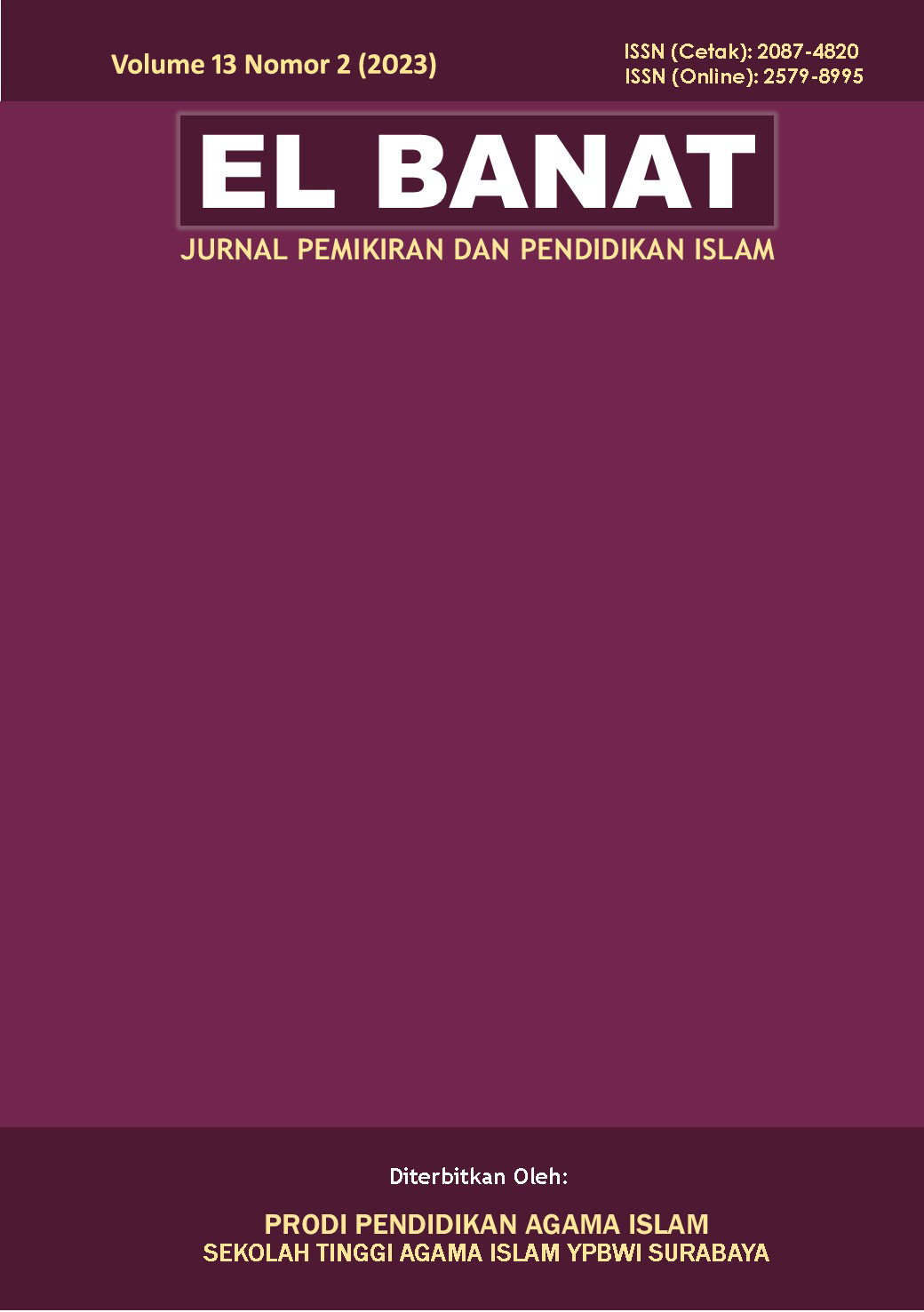Dinamika Agama, Pendidikan, Sosial dan Budaya Masyarakat Urban di Madura
DOI:
https://doi.org/10.54180/elbanat.2023.13.2.351-370Keywords:
Religious Dynamics, Education, Socio-cultural, Urban SocietyAbstract
Social and cultural changes that occur in urban society have resulted in a shift in religious values, where religion is only used as symbols of self-identity. This behavior pattern tends to lead to the formation of self-imitation. This results in social inequalities and changes in religious, social and cultural values. This research tries to analyze the religious, social and cultural changes that have occurred in the community of Sukolilo Village, Labang District, Bangkalan Regency, which have had a lot of influence on their life patterns. This research uses a phenomenological approach. Meanwhile, this type of research is descriptive research. The results of the research show that the dynamics of religion lead to the mosque being a place of worship for Muslims. Apart from being a center for religious activities, the mosque is also a center for social activities. Social dynamics show that the level of education in Sukolilo Bangkalan is relatively low, with minimal children continuing their education to high school level. Community employment, namely work in the service and informal sectors. Meanwhile, in the cultural aspect, the language used by the majority of people is Madurese which is very dominantly used as a means of communication in their daily activities in their environment with some mixture of Javanese language originating from Surabaya. The author argues that this dynamic becomes a social inevitability amidst the intersection of several aspects above, which coincides with the roar of information "spillover" in society
Downloads
References
Asy’ari, Musa, Heddi Shri-Ahimsah Putra, dan Mulyadi Kertanegara. “Pengembangan Masyarakat Islam: Agama, Sosial, Ekonomi dan Budaya.” Dalam jurnal Populis, Edisi
III. struktur ekonomi rakyat, berskala kecil, mikro, dan untuk memenuhi kebutuhan-kebutuhan masyarakat secara umum (2003).
Gilbert, Alan, dan Josef Gugler. “Urbanisasi dan Kemiskinan.” Yogyakarta: PT. Tiara Wacana Yogya (1996).
Hamali, Syaiful. “Agama dalam Perspektif Sosiologis.” Al-Adyan: Jurnal Studi Lintas Agama 12, no. 2 (2017): 223–244.
Harahap, Fitri Ramdhani. “Dampak urbanisasi bagi perkembangan kota di Indonesia.” Society 1, no. 1 (2013): 35–45.
Hasan, M Iqbal. “Ahmadi, Rulam. Metodologi Penelitian Kualitatif (Yogyakarta: Ar-Ruzz Media, 2014). Bungin, M. Burhan. Penelitian Kualitatif: Komunikasi, Ekonomi,
Kebijakan Publik, dan Ilmu Sosial Lainnya,(jakarta: Kencana, 2007). Departemen pendidikan dan kebudayaan, Kamus besar bahasa Indonesia.” Focus 1, no. 3 (2018).
Hassan, Fuad. Cultural Dimension and Human Development. Balai Pustaka, 1992.
Hidayati, Inayah. “Urbanisasi dan Dampak Sosial di Kota Besar: Sebuah Tinjauan.” Jurnal Ilmiah Ilmu Sosial 7, no. 2 (2021): 212–221.
Koentjaraningrat, Raden Mas. Anthropology in Indonesia: a bibliographical review. Brill, 1975.
Liliweri, Alo. “Dasar-dasar komunikasi antar budaya” (2020).
mahfud Mahfud, Choirul. “The Genealogy of Social History of Islamic Education Politics In Indonesia.” Al-Tadzkiyyah: Jurnal Pendidikan Islam 10, no. 1 (2019): 1–12.
Marzali, Amri. “Pergeseran orientasi nilai kultural dan keagamaan di Indonesia.” Antropologi Indonesia 57, no. 12 (1998): 13–19.
McGee, Terence Gary. The urbanization process in the third world. London: G. Bell and Sons, Ltd, 1971.
Merrill, Francis Ellsworth, dan H Wentworth Eldredge. “Society and culture: An introduction to sociology.” (No Title) (1961).
Mitchell, Geoffrey. A new dictionary of the social sciences. Routledge, 2017.
Moleong, Lexy J. “Metode penelitian kualitatif edisi revisi.” Bandung: PT Remaja Rosdakarya (2014).
O’dea, Thomas F. “Sosiologi Agama Suatu Pengantar.” Jakarta: Pustaka Sinar Harapan (2001).
Parsons, Talcott. “Religion in postindustrial America: the problem of secularization.” Social Research (1974): 193–225.
Ramayulis, Ilmu Pendidikan Islam. “Metodologi pengajaran agama Islam.” Jakarta: Kalam Mulia (2001).
Riduwan, Riduwan, dan Amir Mahmud. “Integrasi Agama dan Sains dalam Sistem Pendidikan Model Kuttab.” EL-BANAT: Jurnal Pemikiran dan Pendidikan Islam 13, no. 1 (2023): 85–104.
Ritzer, George. “Sosiologi: ilmu pengetahuan berparadigma ganda.” (No Title) (1985).
Suprayogo, Imam. “Drs. Tobroni, M. si.” Metodologi Penelitian Sosial Agama (n.d.).
Tjiptoherijanto, Prijono. Migrasi, Urbanisasi dan Pasar Kerja di Indonesia. Penerbit Universitas Indonesia (UI Press), 1997.
———. “Pengentasan kemiskinan melalui pembangunan jaringan ekonomi pedesaan (sebagai suatu strategi).” Populasi 8, no. 2 (1997).
———. “Urbanisasi dan pengembangan kota di Indonesia.” Populasi 10, no. 2 (1999): 57–72.
Tylor, Edward Burnett. “The science of culture [1873].” Readings for a history of anthropological theory (2021): 19–31.
Ulfah, Elok Maria. “Dinamika Masyarakat Urban.” Dirasah: Jurnal Studi Ilmu dan Manajemen Pendidikan Islam 4, no. 1 (2021): 118–133.
University of California (BERKELEY, Calif.). Survey Research Center, Charles Y Glock, dan Rodney STARK. American Piety: the Nature of Religious Commitment. By Rodney Stark and Charles Y. Glock. A Publication from the Research Program in Religion and Society of the Survey Research Center, University of California, Berkeley. University of California Press, 1968.
Usman, Sunyoto. Pembangunan dan pemberdayaan masyarakat. Pustaka Pelajar, 1998.
Wach, Joachim. “The Place of the History of Religions in the Study of Theology.” The Journal of Religion 27, no. 3 (1947): 157–177.
Widiawaty, Millary Agung. “Faktor-faktor Urbanisasi di indonesia” (2019).
Yazid, Muhammad Farhan, Nadya Fitri, dan Surya Fadhil Burtama. “Meningkatkan Antusiasme Masyarakat Dalam Kegiatan Keagamaan Di Desa Jagabaya.”
PROCEEDINGS UIN SUNAN GUNUNG DJATI BANDUNG 3, no. 3 (2023).
Yazid, Tariq, Muslim Hidayat, dan Laili Hidayati Khoirunnisa. “Communication and Psychology of Religious Behavior (Case Study of Religious Leaders in Jatinom
Klaten).” Kalijaga International Journal of Social Sciences and Humanities 1, no. 1 (2022): 45–52.





